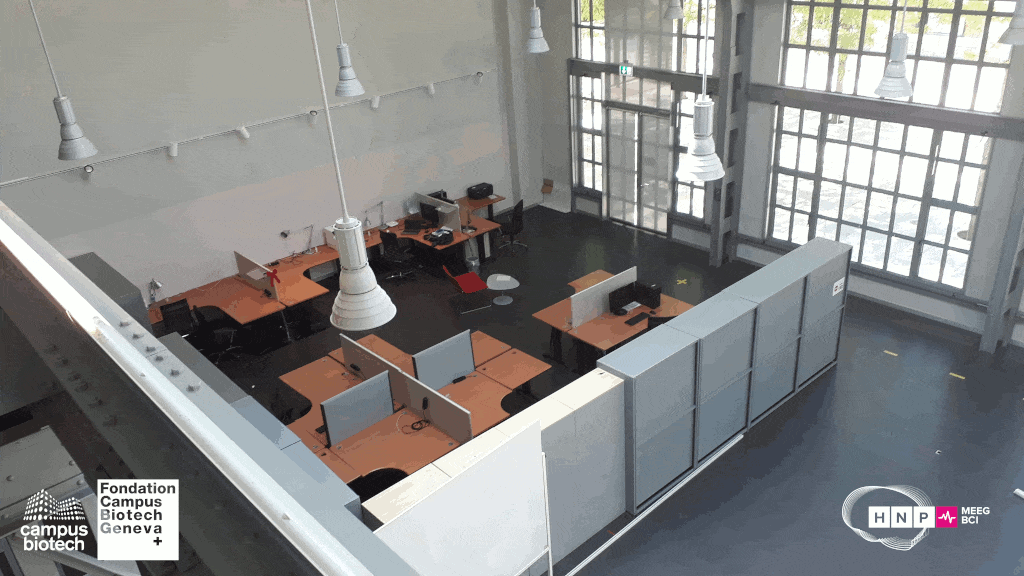
GUEST EXPERT
THE LANGUAGE OF MEG
HOW DOES MEG HELP NEUROSCIENCE

Prof. Anne-Lise Giraud, director of the Institut de l’Audition in Paris and co-director of the NCCR Evolving Language, was one of the initiators of the purchase of the magnetoencephalography (MEG). She agreed to explain why such a scanner is essential for Swiss human neuroscience research.
How long have you been using an MEG and what is the big advantage of the MEG in comparison to other scanners?
I started human functional neuroimaging in the late 90s with PET and fMRI and quickly realized that we were very limited in the study of dynamic processes by the low temporal resolution of these techniques. I then had the choice between EEG and MEG, but being used to the excellent spatial resolution of fMRI, I became quickly frustrated by the uncertainties about the localization of the sources of neural activity using EEG, as these are estimated given a electrical current flow between the neural activity source and a reference. With MEG the sources are below the sensors, which makes the source reconstruction problem easier and more reliable. In addition, having compared EEG and MEG in a few studies, I also realized that weak activity in the high frequency domain was better captured with MEG than EEG. Finally MEG is much easier to operate as the patient/subject can go in the scanner without preparation or discomfort, and we do not have to worry about loss of sensor sensitivity in the course of our experiments.
Until the arrival of the MEG scanner in Geneva, running an MEG study required going abroad for data acquisition campaigns. Fortunately, MEG is quite densely implanted in France or Germany.

Future implantation site of the MEG platform at Campus Biotech. The MEG should be operational in the fall 2022.
Why do you think the HNP is the perfect place to host it?
I would say it goes both ways. The HNP is the perfect host for the MEG because it is organized in platforms that are open to the whole research community. Therefore it can be expected that the whole Switzerland community will benefit from it. Reciprocally, MEG is also an indispensable addition to the already very comprehensive portfolio of human neuroscience tools. Within a few years, the HNP has become a worldwide leader in terms of equipment for human brain research.
How does this scanner fit into your research programme on language?
MEG is essential for the study of language as it is a dynamic system that requires understanding on-line precise computations. MEG is especially sensitive to signals that come from sulci, so ideal for exploring for instance the auditory cortex, but all functions that take place in regions that are not tangential to the cortical surface.
Having an MEG in Geneva, close to the HUG, will be an immense advantage as we will be able to study patients who have implanted electrodes and compare intracortical electrical signals with surface magnetic signals, an essential step to understand the exact nature of these signals and how they relate to each other, in particular but only in the context of language processing. Comparing surface and intracortical signals is not feasible with EEG, mostly due to risks of infection.

You’re the co-director of the NCCR Evolving Language. To what extent can the MEG be used for the research conducted within this national consortium?
The MEG is an ideal tool to study the neural dynamics of language which is one of the goals of our consortium. We study speech processing at UNIGE, but our colleagues in Zurich study higher processing levels in language such as syntax planning. They are also very much looking forward to being able to use this tool. For instance we hope to use MEG for developing brain computer interface systems which can be expected in the long run to help patients with speech production disorders.
Thanks to the partnership, all NCCR members will have the opportunity to use the MEG and won’t need to go abroad for their research. And owing to a new NCCR professorship in dynamics of cerebral functions we will be able to develop an MEG culture which will prepare us all for future developments in the MEG domain.
MEG ON CAMPUS IN 2022
The Human Neuroscience Platform (HNP) at Campus Biotech will acquire and install a new MEG platform in summer 2022. The new MEGIN TRIUX™ neo will integrate the already existing MEEG-BCI MRI facility.
This ambitious project is the result of an exciting collaboration between the NCCR Evolving Language, the Geneva University Hospitals (HUG), the University of Geneva (UNIGE), the Ecole Polytechnique Fédérale de Lausanne (EPFL) and the Fondation Campus Biotech Geneva (FCBG).

